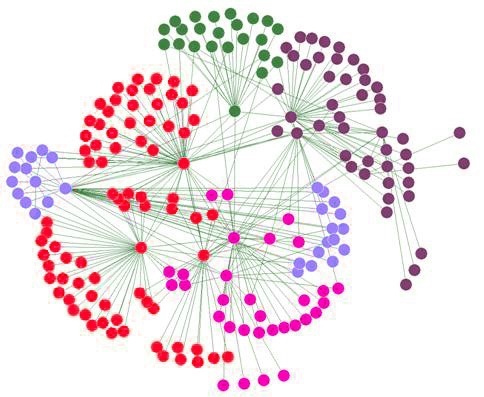Epidemic Growth in Fits and Starts
What can your Facebook network tell you about measles in Texas, the growth of online influence, or the growth of your business.
A measles outbreak in Texas has been popping up in the news throughout the past week. As I write this newsletter, there are currently 58 confirmed cases. So far the outbreak is confined mostly within Gaines County which has a measles vaccine exemption rate of 18% - meaning fewer than 82% of the children in the county are vaccinated against measles. Some school districts and communities within the county are significantly lower than the average. One public school district within Loop, TX has fewer than 50% of children vaccinated for measles.
Measles is very contagious. If a child is unvaccinated and has never had measles before they will be infected with a very high probability once exposed. The typical child will spread a measles infection to 12-15 others, on average, if no vaccines exist. With measles vaccination rates this low in the local area of the Gaines outbreak, it has not been not surprising to see measles spread widely once the outbreak started.
As the outbreak continues to spread, we should be increasingly concerned that the outbreak will find yet another area like Gaines with low rates of vaccination nearby. (I have written before that even areas with high average vaccination coverage can have schools with rates of coverage much lower than the average.) This is how large and widespread outbreaks are sustained. To understand how this process works, think about how the size of your online social network expands across Facebook, Instagram, or whatever platform you use most frequently. When you first created your account, you likely connected with a core set of friends and family. Maybe you start with your partner, your parents, your four best friends, and three co-workers – you had ten connections. Your network probably grew pretty quickly at first. You added on some peripheral friends, a few more coworkers, and a cousin or two. But, at some point you likely hit a threshold where your network size hit a plateau. Maybe it was at 100 people. It probably ticked up slowly after this but only at a rate of a connection or two each week.
Then by happenstance, you ran across an old friend from high school. You connect with your old friend online. The old friend suddenly opens up the growth of your social network to another set of people because they are connected to twenty more people you know from high school and a few of your old teachers. All of a sudden you go from 100 people to 125 in a day or two. Then things settle down again and continue to grow by one or two people per week. Then one day you connect to a second cousin that you haven’t seen since childhood. They open up another new path of growth to other cousins, aunts and uncles. You have another period of short but large growth.
As a visual consider the graph below. Each of the different colors is a different aspect of your life. Perhaps red is family, dark purple co-workers, light purple in-laws, green high school friends, and so on. Each time that you break into one of these sets you see another boom in the growth of your online network.
Example graph from an online tutorial: https://stackoverflow.com/questions/47702142/how-do-you-group-social-network-nodes
More general online networks are built in the same way. Here however, each color is a group of new people with different sets of overlapping interests. Maybe red is vaccine safety, purple child health, pink epidemiology, etc. Your online influence grows by breaking into these different groups one at a time. Often it is the people on the periphery of each group, the ones that bridge from one group to another, that allow for expansion into new areas of social influence.
Business opportunities can grow in the same way. Maybe a contractor works primarily in a local town. Then they get a referral to someone in a nearby second town. Once in the second town, more referrals develop in that area. Then another town and another. Each time you expand to another town your opportunities for further expansion grow. Likely this growth won’t be linear it will be in fits and starts as you break into new areas and new markets.
These secondary outbreaks are what needs to be stopped in Texas. If we don’t extinguish the outbreak in and around Gaines County, it will eventually find another pocket of unvaccinated and susceptible children and we will be forced to fight another outbreak. Once it is in two communities with low vaccination rates there are even more infected children creating more opportunities to find other unvaccinated groups.
In some ways we saw this with Covid-19. A few cases in the metropolitan areas of New York City and Seattle soon spread to nearby Newark NJ and Stamford, CT on the east coast and Tacoma, WA and Portland, OR on the west coast. Once it took hold in these communities it eventually spread to Detroit, New Orleans, Phoenix, and then the midwestern and southeastern US. Of course, Covid-19 was different. No one had immunity from a previous infection. We couldn’t stop it as easily as we could a measles outbreak.
Unlike Covid-19 we can stop measles outbreaks with the science already at hand. The measles vaccine is highly effective. Two doses of the vaccine for children confer 97% immunity. We need to stop these pockets of unvaccinated children from cropping up with school-based vaccine mandates and only allow exemptions for medical reasons. Every child hospitalized with a measles infection is an easily preventable tragedy.
Troy Tassier is a professor of economics at Fordham University and the author of The Rich Flee and the Poor Take the Bus: How Our Unequal Society Fails Us during Outbreaks.




